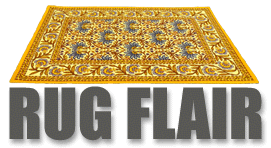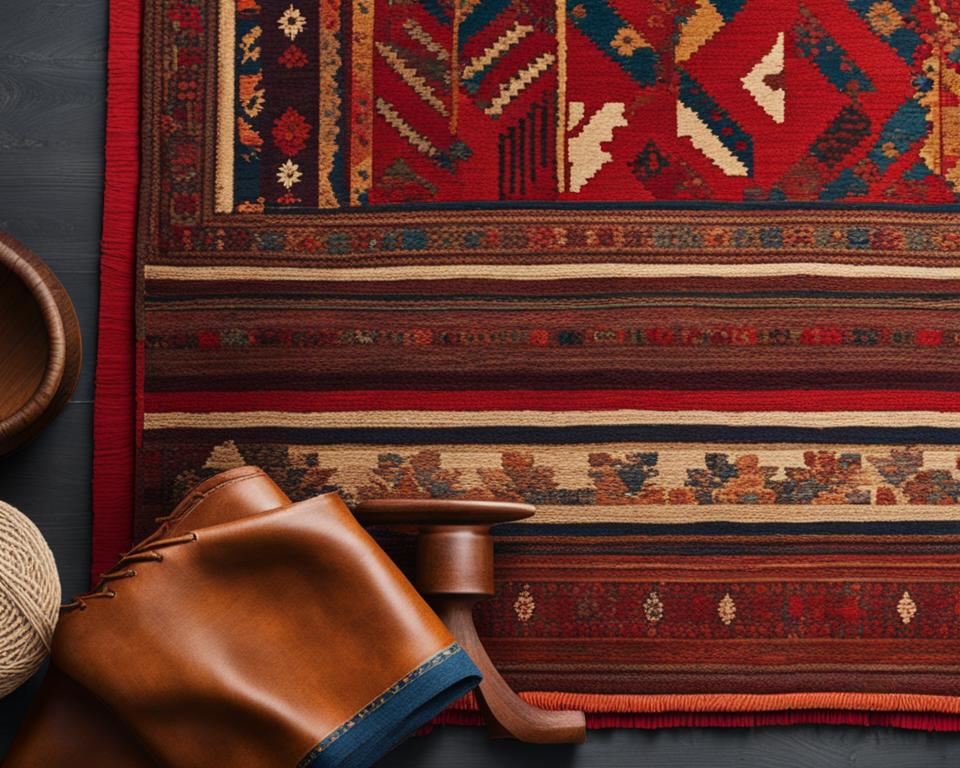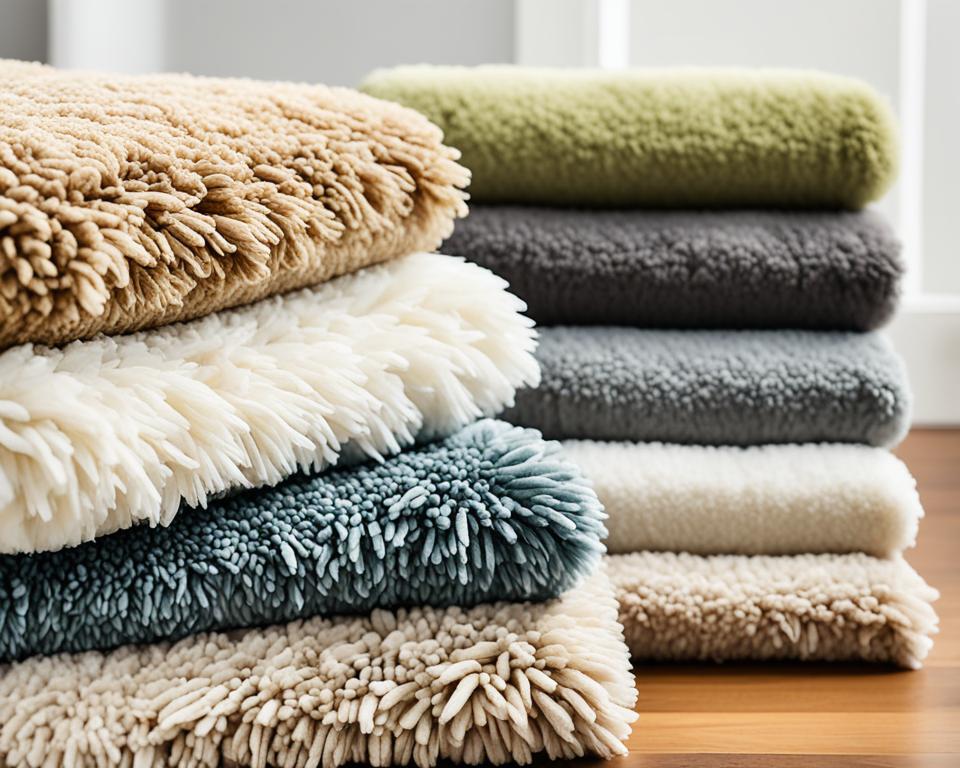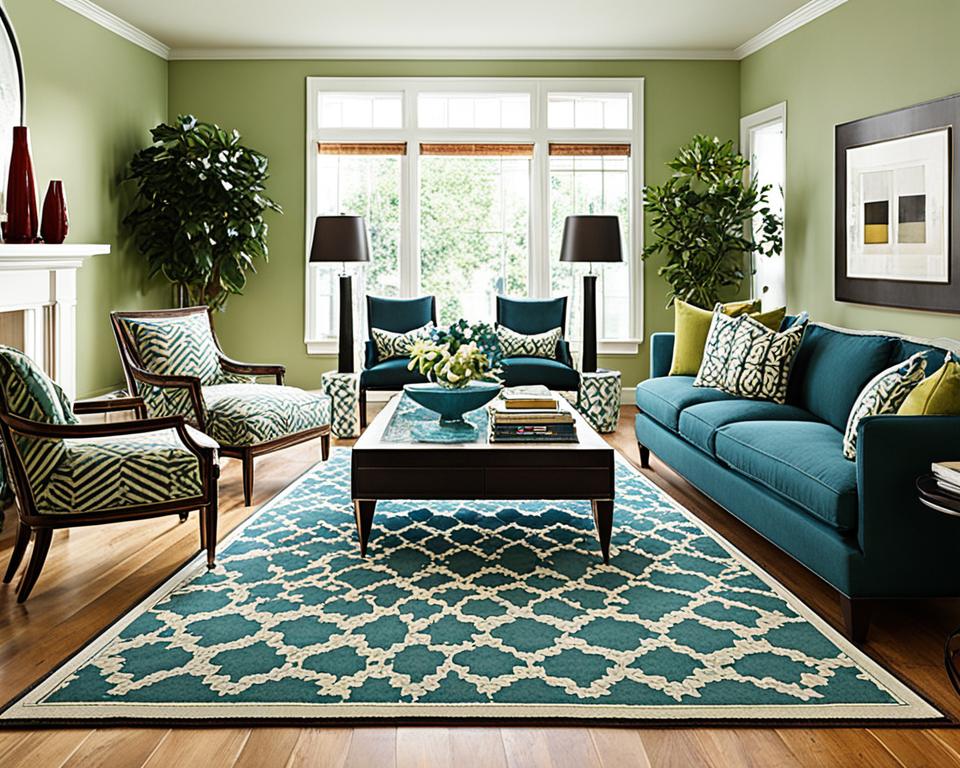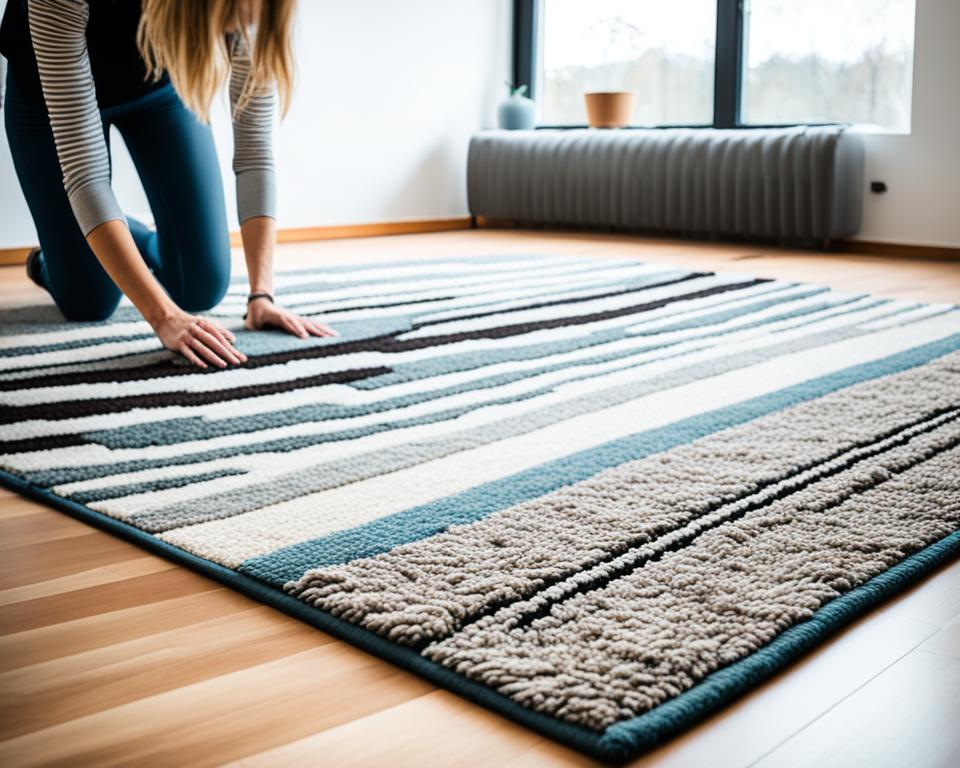Have you ever marveled at the intricate patterns and vibrant colors of a cultural rug and wondered, who invented rugs? Beyond their beauty, these handwoven textiles hold the rich history of rug making, binding the past with every stitch and symbol. Dive into the world of Moroccan rugs and discover the ancient practices that gave rise to this extraordinary art form. The ingenious Berber tribes of North Africa, whose traditions and stories are interwoven into the very fabric of these rugs, pioneered this craft. Embodying a civilization’s narrative, these artisans transformed utility into artistry, creating not just rugs, but legacies beneath our feet.
Key Takeaways
- The history of rug making is a testament to the innovation and cultural significance of ancient civilizations.
- Understanding who invented rugs lends insight into the rich traditions and artistic heritage of societies.
- Moroccan rugs serve as a chronicle of the lives and craftsmanship of the Berber tribes.
- Rug weaving evolved from a functional necessity to a complex form of expression, mirroring societal changes.
- Each cultural rug narrates the unique story of its origins and the people who made them.
- Moroccan artisanal creations are prized for their ability to capture identity and history through weaving.
The Roots of Rug Making in Ancient Civilizations
Delve into the origin of rugs and you will unearth stories of survival, community, and artistry that date back to the cradle of human civilization. The ancient rug makers were not mere artisans; they were pivotal characters in the narrative of humanity’s progress, harnessing the harshness of nature into comfort and splendor within their homes.
From the verdant valleys of the Tigris and Euphrates to the ancient Nile riverbanks, the journey of rug weaving begins. Here, in these time-tested landscapes, lay the humble beginnings of a craft that would, in time, weave its way into the luxurious halls of kings and emperors.
The Practical Beginnings with Natural Materials
Imagine the earthy scent of reeds and grasses and the tactile warmth of animal hides underfoot. These were the materials at the disposal of our ancestors in Mesopotamia, Central Asia, and Egypt. Driven by the need for warmth and respite from the cold grounds of their dwellings, they created the precursors to the modern rug—rudimentary yet revolutionary.
These early floor coverings were not just about physical comfort but also about a sense of place and identity, transforming a space from mere shelter to home. Thus, the rug weaving history began, not with grand tapestries but with simple, practical solutions to everyday challenges faced by ancient communities.
The Advent of Loom Weaving and Textile Progress
With the dawn of technology came the loom, a device that would forever change the trajectory of human textile production. Its introduction marked a turning point in the history of rug making, elevating it from fundamental need to intricate expression.
By 4000 BCE, the loom was well-established in Mesopotamia, signaling the advent of more durable and elaborate fabric creations. The loom’s impact was profound, laying the foundation for what we know as the carpet—a term synonymous with craftsmanship and comfort across cultures and eras.
- Rugs were essential to ancient civilization’s domestic life for warmth and comfort.
- Looms revolutionized textile making, leading to stronger and more intricate rugs.
- The origin of rugs is a testament to human innovation and cultural development.
Who Invented Rugs? The Persian Pioneers
As you marvel at the elegance and sophistication woven into each Persian carpet, you might find yourself questioning its origins. Historically, the title of rug inventor is not attributed to a single individual but rather to the ancient Persian weavers. These pioneers crafted the foundation of the rich tapestry that would evolve into the luxurious floor coverings known worldwide for their imagery and opulent textures. Through their talent, an age-old craft transitioned into a symbol of cultural prestige, creating not only a functional item for daily life but a status symbol for the elite.
The exquisite materials and elaborate motifs of the Persian carpet are not mere coincidences. They are reflections of deep-seated heritage and the influence of dynasties that valued beauty and artistry in even the most mundane objects. It is the Persian rug origins that bear witness to this transformation, with each knot and dye speaking volumes about the craftsmanship integral to Persian culture. As the influence of Persian rugs spread, so too did the fame of their creators, situating them in historical annals as the progenitors of rug making.
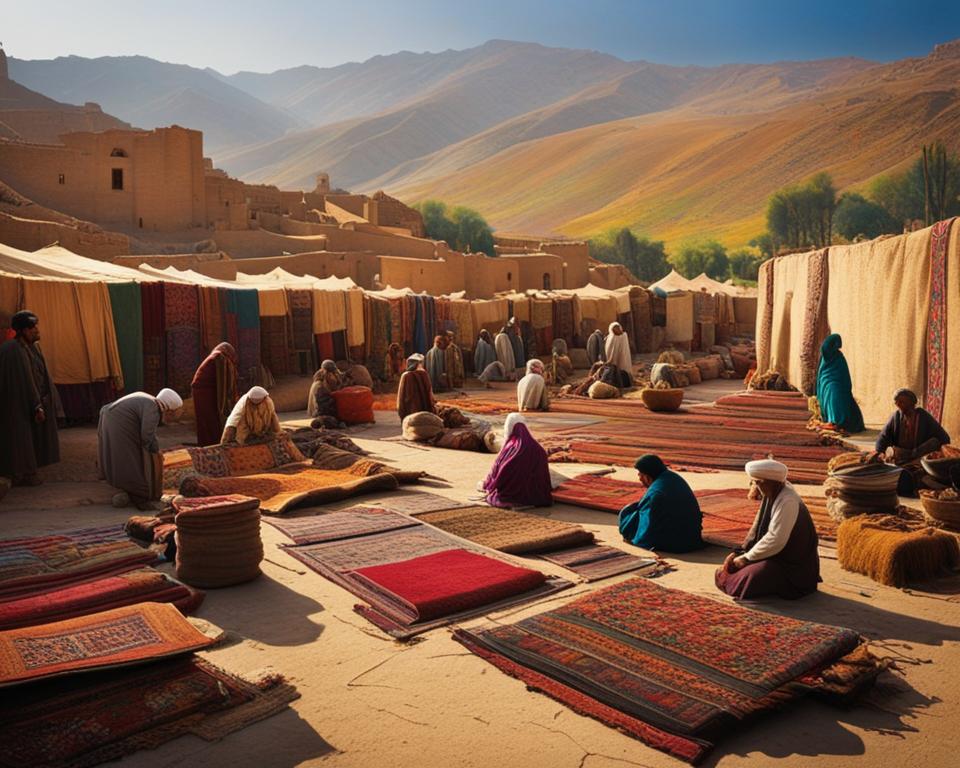
- The complexity of Persian patterns surpasses mere decoration, symbolizing tales of conquest, tales of love, and the celebration of natural beauty.
- Traditions passed down through generations ensure that the skills and secrets of the Persian rug do not age, but instead flourish with time.
- Persian rugs have transformed across eras, their evolution marked by the rise and fall of empires, each leaving indelible marks on their design vocabulary.
Today, the Persian rug remains an international icon of luxury and history, a centerpiece for modern and traditional homes alike. For those who delve into the annals of rug history, the legacy of the Persian artisans provides a fascinating narrative spanning centuries—a testament to the human capacity for artistic expression, and an everlasting homage to cultures that prize beauty and ingenuity.
Moroccan Rug Weaving: An Artistic Legacy
The art of traditional rug creation in Morocco is a visual language that whispers tales of the past and sings the anthem of Berber craftsmanship. It’s a narrative stitched within the very fibers of thoughtfully crafted floor coverings that grace our living spaces. This legacy of handmade rug origins is not merely a craft but a vocation, a living history of Moroccan artisanal creations seamlessly blending with contemporary aesthetics.
Influence of the Berber Tribes in Rug Making
At the heart of Moroccan rug-making lies the spirit and ingenuity of the Berber tribes. Their connection to nature and remarkable adaptability have nurtured a vibrant heritage of handmade rug origins. The weaves and knots encapsulate millennia of wisdom and the rich tapestry of nomadic life. Berber artists use an array of natural dyes and pure wool, infusing each rug with an authenticity that transcends trends.
The Interplay of Culture and Creation in Moroccan Rugs
The fusion of culture in Moroccan rugs vividly manifests in the eclectic symbolism and chromatic storytelling woven into every piece. The language of these rugs is a distinctive one, with each motif and hue a cipher to the environmental cues and social commentary of the Moroccan landscape. From the Atlas Mountains to the bustle of Marrakech, Moroccan rugs carry the cultural DNA of their origin, a testament to the region’s spirited identity.
- Rich Heritage: The rugs echo the ecological and spiritual essence of the Berber tribes, whose ancestral roots feed into the warp and weft of the designs.
- Symbolic Motifs: Patterns often recount folklores, encapsulate tribal myths, or represent familial ties, forging a bond between heritage and art.
- Natural Dyes: Derived from the environment, the dyes not only paint the rugs with the region’s palette but also chronicle the Berber’s interaction with nature.
- Versatile Utility: Once serving the pedestrian need for warmth and seating, Moroccan rugs now fulfill a dual role as both functional objects and conduits of culture.
The Berber-influenced designs are not static relics but dynamic artworks, constantly redefining and adapting themselves to the contemporary demand without losing sight of traditional rug creation. As you stand upon a Moroccan rug, you don’t just stand on a piece of textile; you stand upon centuries of artistry, carefully preserved and passionately shared.
The Pazyryk Carpet: A Window into Ancient Rug Innovation
Embark on a journey back in time and explore the history of rug making through the Pazyryk Carpet, a testament to ancient craftsmanship. Discovered in the icy tombs of Siberia, the Pazyryk Carpet is an archaeological wonder that has captivated historians and art enthusiasts alike. Dating to the 5th century BCE, this oldest known rug represents an era where the rudimentary began to morph into the refined, and utility embraced elegance.
Featuring a symmetrical knot structure and motifs eerily reminiscent of Persian art, the Pazyryk Carpet embodies the cultural exchange and artistic innovation that characterized ancient rug making. This masterful creation stands as a silent narrator, recounting a history replete with intricate designs and narratives spun meticulously by hand.
As you ponder this artifact, consider it not just as a mere fragment of the past but as a connecting thread to the lives of those who tread upon it millennia ago. The artistry of the Pazyryk Carpet with its rich dyes and meticulous patterns transports you to an ancient workshop, where each thread serves as a stroke of the artisan’s genius—a legacy of resilience against time’s relentless march.
- Oldest known rug, communicating the sophistication of ancient artisans.
- Connection to the wider history of rug making and Persian influence.
- An artifact symbolizing across generations the tale of creativity and cultural identity.
The Pazyryk Carpet illuminates much more than the aesthetics of its time—it showcases the emergence of rug making as a sophisticated art form that transcended its practical beginnings. Uncover the layers of history woven into the Pazyryk Carpet, and you reveal a detailed chronicle of ancient ingenuity.
The Evolution of Rug Weaving Techniques and Styles
Witness the incredible transformation within the world of textiles as your gaze travels across the warp and weft of history. You’ll see the evolution of rug weaving emerge from its chrysalis of simplicity to don the splendor of complexity and artistry.
The timeline of rug making techniques marks a fascinating journey from basic necessities to magnificently ornate art forms. It’s a progression that charts the ingenuity and cultural vibrance of ancient civilizations. Let’s explore the materials and designs that played a pivotal role in shaping what we now celebrate as the sophisticated artistry of rug making.
The Introduction of Luxurious Materials and Complex Designs
As societies flourished, so too did their desire for luxury and intricacy in everyday objects. The Persian artisans, renowned for their profound connection to beauty, began incorporating sumptuous materials such as silk and fine wools into their rugs. These luxurious materials paired with the introduction of exotic dyes extracted from plants, minerals, and insects paved the way for a spectrum of vibrant colors unseen in earlier works.
Such innovation allowed for complex designs to unfold upon the canvas of these early rugs, with patterns that told tales of gods and beasts, of victories and the ebbs of daily life. Ancient rug designs became rich with meaning, transforming every rug into a storied tapestry.
From Tribal Patterns to Sophisticated Artistry
Moving beyond the constraints of mere survival, the tribal patterns that initially characterized early rugs evolved into emblems of sophisticated artistry. Designs became more than functional; they echoed the identity, myths, and spiritual beliefs of their creators.
With each pass of the shuttle through the loom’s strings, a new chapter of the evolution of rug weaving was written. These chapters are filled with an array of ornamental riches, from the bold geometrical arrangements to the flowing botanical vines—a reflection of both the artisan’s environment and their flourishing creativity. Indeed, the very soul of ancient civilizations is captured within the dense knots and delicate fringes of these textiles.
Today, each rug—whether displayed on a wall, or laid proudly on the floor—remains a palpable connection to our past. Through their enduring beauty, ancient rug designs continue to narrate the tales of human ingenuity and adaptability, a celebration of both form and function that has stood the test of time.
Embrace the history under your feet; each step is a passage through time, tracing the lines of an ever-evolving legacy of sophisticated artistry.
Global Exchange: The Role of Trade Routes in Rug Diversity
Imagine the vibrant bazaars of ancient times, where the Silk Road converged with myriad cultures – this was the cradle of rug diversity. The global rug trade, spanning continents, is a testament to the binding power of beauty and commerce. Persian and Oriental rugs, with their elaborate motifs, are much more than stunning decor; they are historical emissaries of cross-cultural exchange.
Rug diversity flourished along these rich trade routes, with caravans bearing the weight of woven masterpieces. It wasn’t just goods that were exchanged but also ideas, patterns, and techniques. The Silk Road served as a loom of sorts, intertwining Eastern mystique with Western demand, propelling the craft into new realms of artistic expression.

The result? A stunning variety of styles and traditions that tell a story through each weave. From the intricate Persian carpets of Isfahan to the bold designs of Central Asia, each rug is a footstep along this ancient path of trade and culture. Let’s delve into a comparative exploration of how these trade networks influenced the range of designs seen across the globe.
| Region | Style Influences | Materials Used | Notable Designs |
|---|---|---|---|
| Persia (Iran) | Elaborate motifs, medallions, floral patterns | Silk, Wool, Cotton | Isfahan, Tabriz, Nain |
| Central Asia | Bold, geometric shapes, symbolic elements | Wool, Camel Hair | Turkmen, Bukhara |
| China | Imperial artistry, mythical creatures, landscape scenes | Silk, high-quality wool | Beijing Imperial Carpets |
| India | Mughal influence, garden motifs, palatial designs | Silk, Cotton, Jute | Kashmir, Jaipur |
The heart of the global rug trade beats in these intersections where Eastern artistry meets Western opulence. Your home might boast a rug that is, in essence, a piece of this magnificent history, imbued with a spirit that has traversed space and time. Allow its intricate details to not only adorn your space but also to connect you to the Silk Road’s legacy, where the rug diversity we see today first began to unfurl.
Rugs as Objects of Status and Diplomacy
Throughout history, rugs have not only been a testament to the artistry and culture of ancient civilizations but have also played pivotal roles in historical diplomacy. Often presented as luxurious gifts, rugs have been instruments in forging alliances and displaying wealth, power, and refined taste. The influence of European demands on rug artistry marked a significant chapter in the tapestry of this long-standing tradition.
The Symbolic Value of Rugs in Historical Power Dynamics
Rugs as status symbols represent more than just decorative pieces; they are emblems of social and political stature. In the corridors of power, where historical diplomacy reigned supreme, the exchange of ornate rugs was a common practice. These textiles were heralded for their exquisite craftsmanship and complexity, symbolizing the wealth and sophistication of their owners. Rugs were often selected as gifts for their exceptional quality and beauty, conveying respect and regard in every fiber.
When rulers and dignitaries sought to solidify alliances, the giving of luxurious rugs served as a concrete embodiment of commitment and friendship. This tradition of gifting woven masterpieces has left an indelible mark on the historical narrative, illustrating the profound significance textiles held in the realms of influence and prestige.
European Influence on Rug Artistry and Exchange
With expanding trade routes came the cross-pollination of cultures, and European influence on rug artistry became increasingly evident. The appetite for Oriental carpets led to a fusion of Eastern techniques with Western aesthetics, further enriching the tradition and diversity of rug designs. European sensibilities introduced new motifs and color palettes, which in turn were seamlessly blended with traditional patterns from the rug-making regions.
The international rug trade thrived, as European demand shaped not only the designs but also the economies of those creating these sought-after works of art. This intercontinental dialogue in textile artistry brought disparate cultures together, merging their legacies and creating a shared history that was woven into the very fabric of the rugs themselves.
In the grand halls and stately homes of Europe, these rugs communicated a sense of worldliness, luxury, and appreciation for global artistry. As such, they took their place among the pantheon of cultural symbols that defined not just individual taste but also the expansive reach of civilizations.
The Influence of Conquests on the Rug Making Tradition
As you walk across the regal tapestry beneath your feet, you’re stepping over centuries of history shaped by the rise and fall of empires. The rich cultural rug legacy we admire today is immensely indebted to significant periods of conquest, particularly those of the Ottoman and Safavid dynasties. Their imperial touch imparted a vital shift in rug making, weaving the essence of their reign into the very threads of these textiles. With opulent designs and materials, the rugs from these eras serve as tessellated timelines, recording the affluence and aesthetic found in the corridors of power.
The Ottoman and Safavid Impact on Rug Designs
Lavish floral patterns and intricately woven motifs are hallmarks of Ottoman influence in the domain of rugs, masterpieces that loudly proclaim the empire’s grandeur. Meanwhile, Safavid rugs are testament to Persian ingenuity—an infusion of artistic vision with each hand-tied knot, resonating the empire’s intellectual and cultural zenith. Both empires, flourishing between the 14th and 18th centuries, bestowed upon the rug making craft a newfound opulence that transformed pieces of fabric into esteemed works of art, forever altering the path of the traditional rug creation narrative.
The cultural rug legacy we cherish owes much to the Ottoman influence and Safavid prowess, where the two met at the crossroads of history, in an exchange of artistic ideals and textile technologies. This period elevated the status of the humble rug from a staple of home utility to a prized possession flaunted in palatial halls and diplomatic exchanges. The intricate artistry of these rugs encapsulates a form of silent diplomacy—a showcase of power, a whisper of alliance, and a mandate of cultural supremacy.
Embracing a rug today ties you to this complex heritage, a tangible echo of the Ottoman influence and Safavids’ refined taste. As the custodian of such a cultural heirloom, your space becomes a gallery where every guest is invited to marvel at the legacy woven through centuries, a cultural continuum spun from conquests and the desire for beauty.
FAQ
Who invented rugs?
The exact inventor of rugs is not known, but the history of rug making stretches back to ancient civilizations. Persians are often credited for transforming rudimentary floor coverings into luxurious carpets, making them synonymous with rug crafting expertise.
What materials were initially used in rug making?
Early humans made floor coverings out of materials readily available in their environment, such as reeds, grasses, and animal hides. These were used for warmth, comfort, and insulation inside dwellings.
How did the invention of the loom advance rug making?
The loom was a technological breakthrough that allowed for the creation of more intricate and durable fabrics. Established by 4000 BCE in ancient Mesopotamia, the loom was pivotal in transforming textile traditions, leading to the rugs we recognize today.
Why are Persian rugs renowned?
Persian rugs are distinguished by their high-quality materials, intricate patterns, and elaborate color schemes. Their sophisticated designs have become symbols of luxury and status, with a history interwoven with cultural and artistic significance.
How have the Berber tribes influenced rug making?
The Berber tribes of North Africa, with their distinctive use of natural dyes and symbolic designs, have had a profound impact on the art of rug making. Their techniques are a significant part of their heritage and are intrinsic to traditional rug creation practices.
What is the cultural significance of Moroccan rugs?
Moroccan rugs encapsulate the history and artistry of the region’s environment and the societal changes the people faced. Each pattern and color tells a story, with the rugs serving as a form of identity and a record of the lives of their creators.
What can we learn from the Pazyryk Carpet?
The Pazyryk Carpet, the oldest known surviving rug, provides insight into ancient rug making, featuring symmetrical knots and rich motifs that bear a striking resemblance to Persian artistry. It is an invaluable artifact that demonstrates the historical significance of rugs.
How did rug weaving techniques evolve over time?
As civilizations developed, rug weaving techniques grew in complexity, incorporating more luxurious materials and elaborate designs. The art of rug weaving evolved from simple, practical items to detailed works of art reflecting the weaver’s environment and society.
How did trade routes contribute to rug diversity?
Flourishing trade routes like the Silk Road were instrumental in the spread of rug weaving knowledge and styles. This led to an exchange of artistic ideas and technical skills, which greatly influenced the variety of rug styles and techniques across different cultures.
What role did rugs play in historical diplomacy and social status?
Rugs transcended their utilitarian use to become symbolic items of significant value. Often seen as luxurious gifts, rugs were used in establishing alliances, showcasing influence in social and political spheres, and reflecting wealth and power.
How did European demand influence rug designs?
European tastes and iconography influenced traditional rug patterns, incorporating Western aesthetics into the design. This interplay of cultures contributed to the international rug trade and the artistic evolution of rug designs globally.
How did the Ottoman and Safavid empires influence rug designs?
The Ottoman and Safavid empires introduced lavish floral patterns and luxurious textiles into rug making. Their influence is seen in the opulent artistic styles and intricate designs that have been incorporated into rug making, reflecting the taste and wealth of these historical powers.
